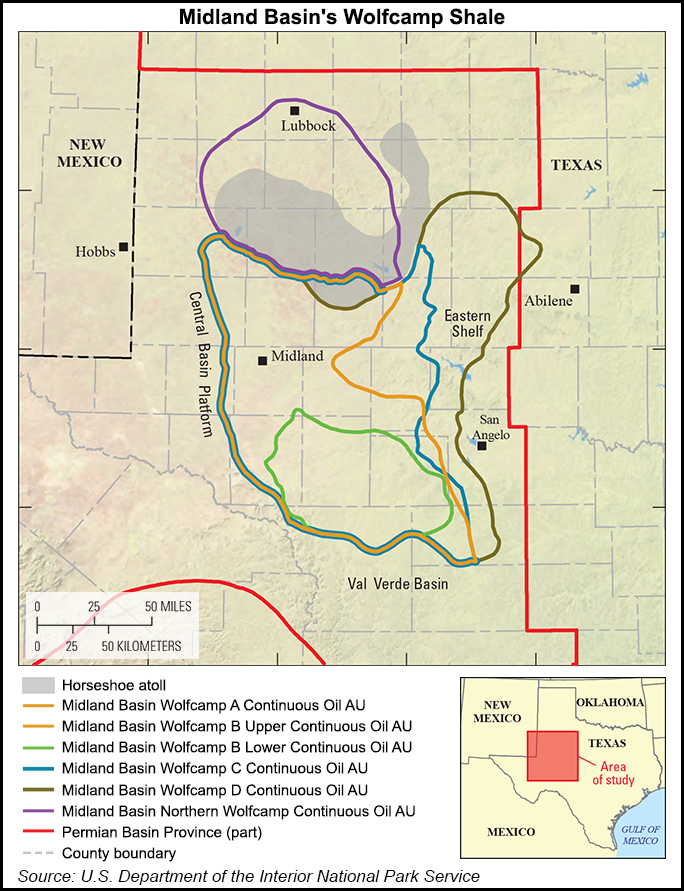E&P | NGI All News Access | NGI The Weekly Gas Market Report | Permian Basin
Wolfcamp Shale in Permian’s Midland Three Times Larger Than Bakken-Three Forks, Says USGS
In the largest estimate ever of unconventional oil in the United States, the U.S. Geological Survey said the Wolfcamp Shale within the Permian Basin’s Midland formation in West Texas contains an estimated mean of 20 billion bbl of oil, 16 Tcf of associated natural gas and 1.6 billion bbl of natural gas liquids.

The new assessment is for continuous, aka unconventional, oil and gas considered undiscovered, technically recoverable resources. Based on the analysis, the Wolfcamp — in the Midland sub-basin only — is nearly three times larger than the Bakken-Three Forks resource, based on an assessment in 2013 by USGS. Researchers concluded that the Wolfcamp has the largest estimated continuous oil accumulation ever assessed in the United States.
“The fact that this is the largest assessment of continuous oil we have ever done just goes to show that, even in areas that have produced billions of barrels of oil, there is still the potential to find billions more,” said USGS Energy Resources Program coordinator Walter Guidroz. “Changes in technology and industry practices can have significant effects on what resources are technically recoverable, and that’s why we continue to perform resource assessments throughout the United States and the world.”
“Continuous” oil and gas is dispersed throughout a geologic formation rather than existing as discrete, localized occurrences, such as those in conventional accumulation. Because the resources are dispersed, they commonly require special technical drilling and recovery methods, such as hydraulic fracturing and horizontal drilling.
The Permian’s overall resources already have been assess by USGS, but the latest review is the first of the Wolfcamp’s continuous resource potential specifically within the Midland sub-basin.
Since the 1980s the Wolfcamp has been considered part of the Wolfberry play, which encompasses Mississippian, Pennsylvanian and Lower Permian reservoirs. Oil had been produced using traditional vertical well technology, but more recently producers have been using horizontal drilling and hydraulic fracturing.
More than 3,000 horizontal wells have been drilled and completed to date in the Midland’s Wolfcamp, USGS noted. The Wolfcamp formation also runs through the Delaware sub-basin portion of the Permian province, but the Delaware was not included in the new assessment.
The Permian province includes a series of basins and other geologic formations in West Texas and southern New Mexico and has long been considered one of the most productive areas for oil and gas in the Lower 48 states. NGI recently published aspecial report about the Permian on activity and prospects.
Undiscovered resources are considered to exist based on geologic knowledge and theory, while technically recoverable resources are those that may be produced using currently available technology and industry practices. Whether or not it is profitable to produce these resources has not been evaluated. USGS is the only provider of publicly available estimates of undiscovered technically recoverable oil and gas resources of onshore lands and offshore state waters. The Wolfcamp assessment was undertaken as part of a nationwide project assessing domestic petroleum basins using standardized methodology and protocol.
© 2024 Natural Gas Intelligence. All rights reserved.
ISSN © 2577-9877 | ISSN © 1532-1266 | ISSN © 2158-8023 |
